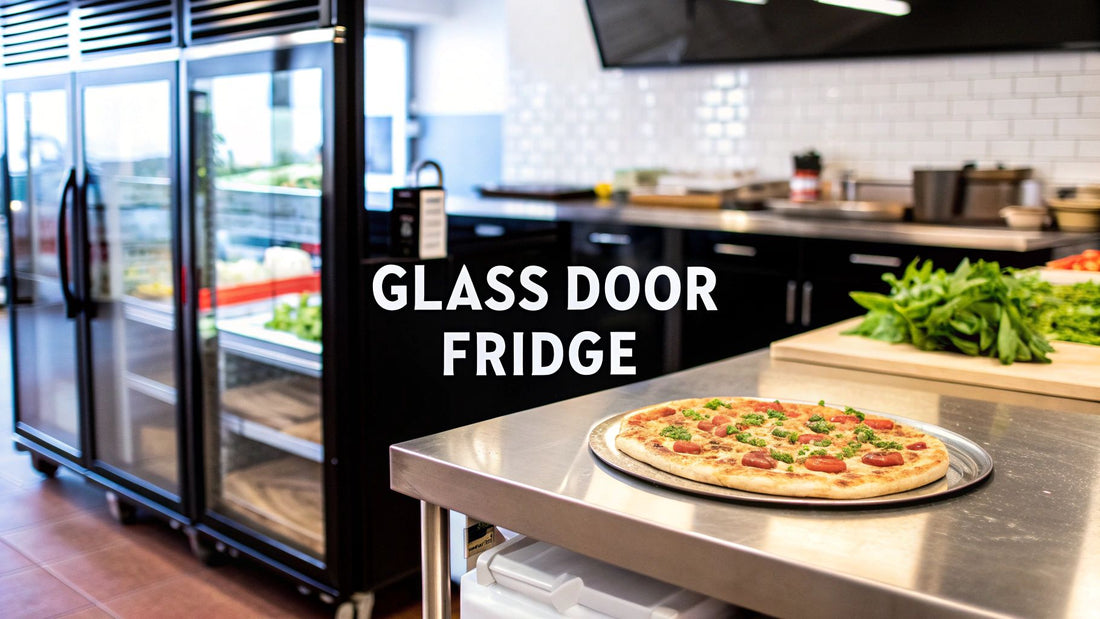
Choosing the Best Glass Door Fridge for Your Pizzeria
Share
For any pizzeria owner, a glass door fridge is way more than just a box that keeps things cold. When you pair it with a good pizza prep table, it becomes the beating heart of your kitchen's speed and efficiency. The see-through doors let your pizza makers spot ingredients instantly, which means less time fumbling around with the door open and more time keeping that precious cold air locked in. This kind of immediate visual access is the secret to a faster, smoother pizza assembly line.
The Secret to a Faster Pizzeria Workflow
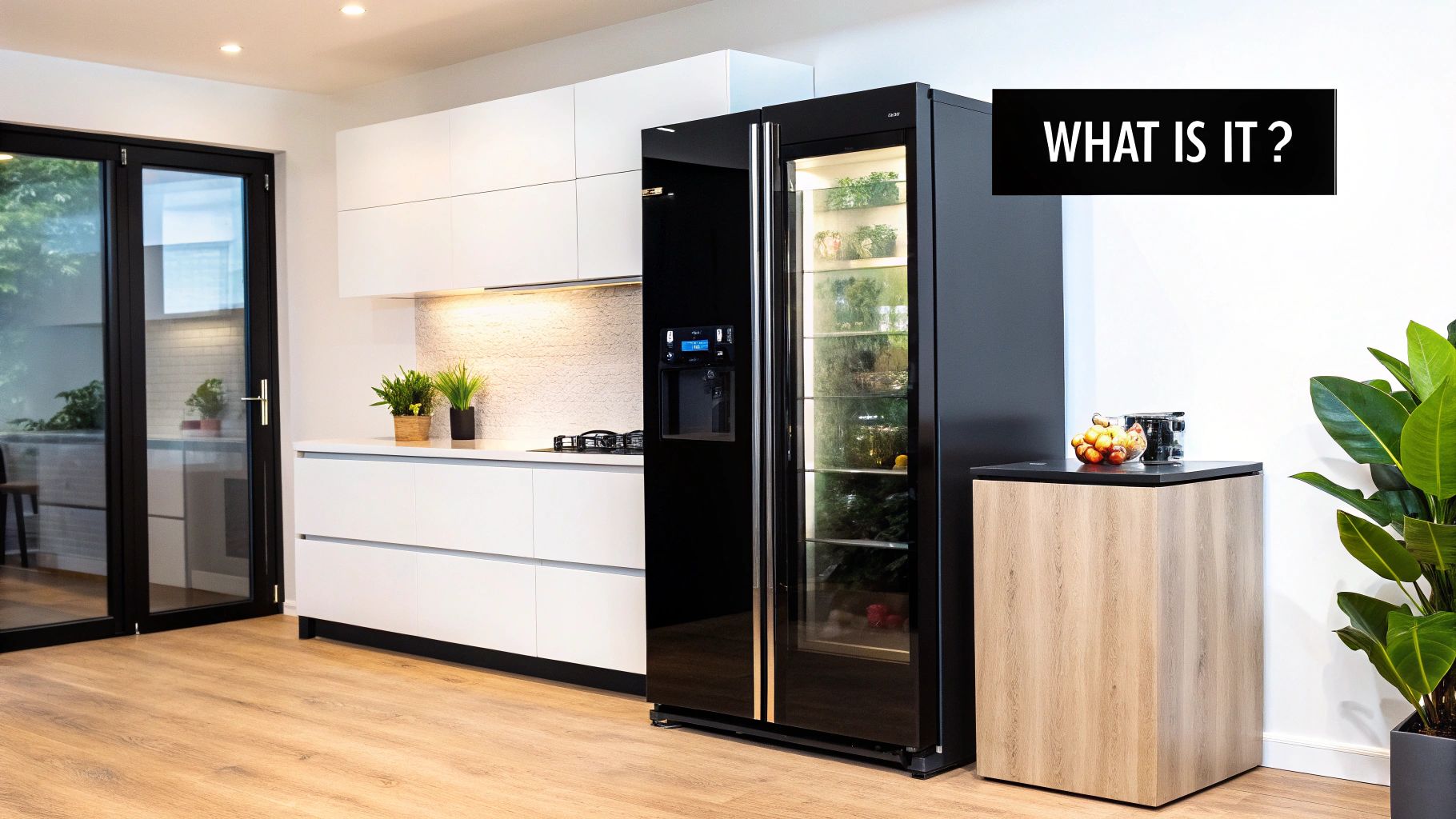
Picture your busiest Friday night. The tickets are flooding in, the pressure is on, and every single second counts. In that kind of high-stakes environment, the line between a smooth service and total chaos often comes down to your workflow. And let me tell you, the right glass door fridge is your pizzeria's secret weapon.
This isn't just about keeping ingredients chilled; it's about building a smarter, more intuitive kitchen. When your team can see exactly where the dough trays, shredded mozzarella, and sliced pepperoni are with just a glance, all that wasted motion disappears. This instant visual inventory translates directly into quicker prep times and fewer mistakes during the dinner rush.
Protecting Your Pizzeria's Cold Chain
That journey an ingredient takes from the delivery truck to the oven is what we call the "cold chain." A reliable glass door fridge is the anchor of this entire process, making sure your quality and safety standards are rock-solid every step of the way. You simply can't compromise on consistent, correct temperatures if you want to preserve the perfect texture of your dough and the freshness of your toppings.
A stable cold chain does more than just satisfy the health inspector; it preserves the flavor and quality that people associate with your signature pizzas. Any break in that chain can mess with everything from how your cheese melts to the integrity of your sauce.
A well-maintained unit is your best defense against the dangerous temperature swings that happen when doors are constantly being opened. Think about it: a solid door forces your staff to open it and start searching, letting all that cold air rush out and making the compressor work overtime. A glass door model, on the other hand, lets them make a decision before ever touching the handle.
The Impact on Kitchen Speed and Consistency
The payoff from this visual workflow goes way beyond just spotting ingredients faster. When your inventory is organized and visible, it empowers your team and streamlines the whole pizza-making process from start to finish.
- Reduced Door-Opening Time: Your crew can pinpoint what they need, grab it, and shut the door fast. This keeps temperature drops to a minimum and helps the unit run more efficiently.
- Fewer Errors: Seeing ingredients clearly cuts down on the chances of grabbing the wrong item—a lifesaver when you're dealing with a pile of custom orders.
- Faster Restocking: It's immediately obvious when you’re getting low on essentials like cheese or popular toppings. This lets you restock your pizza prep table proactively before you're caught empty-handed mid-service.
In the end, a glass door fridge stops being a simple appliance and becomes the central hub of an efficient kitchen. It supports your staff, protects your ingredients, and helps you crank out consistently great pizza, even when the heat is on.
How to Select the Right Size and Capacity
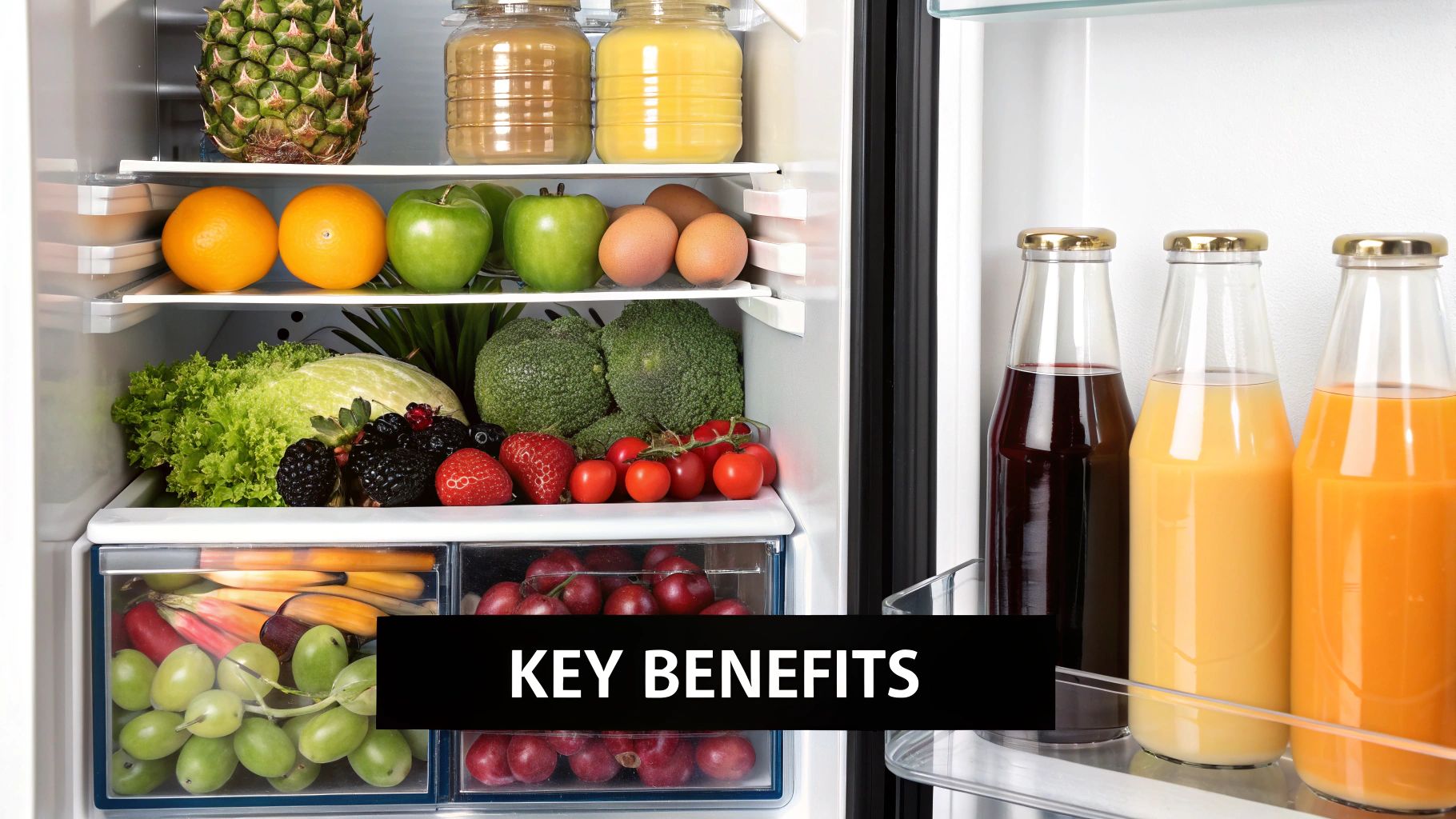
Picking the right size for your glass door fridge is a classic balancing act. Go too big, and you're paying to chill empty air—a real energy hog that drives up your utility bills for no reason. But if you go too small, you’ll hamstring your pizza makers, leading to overstuffed shelves and frantic restocking during the dinner rush.
The trick is to connect the fridge’s capacity directly to your pizzeria's real-world output. It’s not just about cubic feet; it’s about understanding your operational rhythm. This way, you invest in a unit that actually helps you grow instead of holding you back.
These fridges are becoming staples in modern pizzerias for a reason. The global market for glass door refrigerators was valued at USD 13.7 billion and is expected to rocket to USD 19.8 billion by 2030. That growth isn't random—it's driven by kitchens demanding appliances that are both efficient and functional, which is exactly what a busy pizzeria needs. You can dig into these market trends with strategic market insights.
Calculating Your Pizzeria's Needs
To nail down your ideal capacity, start by looking at your sales data. What's the pizza count on your busiest night? That number is the foundation for figuring out how fast you turn over ingredients and how much storage you really need.
Next, get practical about the physical space your ingredients take up. It’s not just about the food, but the containers they live in.
- Bulky Dough Trays: These are notorious space hogs that need deep, clear shelving. Measure your go-to tray and make sure the fridge’s interior depth can handle it without messing up the airflow.
- Large Cheese Blocks: Heavy blocks of mozzarella demand sturdy, adjustable shelves that won’t buckle under the weight.
- Topping Containers for the Prep Table: Think about the Cambro containers or pans you use for pepperoni, mushrooms, and onions. You'll need space for backup pans to quickly swap out on the line.
By figuring out your storage needs based on container size and how much you use daily, you can get a laser-accurate estimate of the capacity you actually need. This simple step prevents some very expensive sizing mistakes down the road.
Strategic Placement for Maximum Efficiency
Where you put your glass door fridge is just as critical as its size. You want to create a seamless workflow that cuts down on staff running around and keeps the pizza line flowing, especially when it’s tied into your pizza prep table setup.
For bulk storage—things like extra dough, cases of sauce, and backup cheese—a big two- or three-door unit tucked away in a back storage area is perfect. It keeps your main prep line clean and ensures you’ve got plenty of stock ready to go.
But for the ingredients you use constantly, a compact undercounter glass door model built right into the pizza prep table is a total game-changer. This puts pepperoni, mushrooms, and cheese right where you need them, shaving precious seconds off every single order. For a deeper dive, check out our guide on choosing the right under counter fridge size for your kitchen. This mix of bulk and point-of-use refrigeration is what separates a good pizzeria from a great one.
Must-Have Features for a Pizza Kitchen
Let's be honest, a pizzeria kitchen is controlled chaos. It's hot, fast-paced, and usually dusted with a fine layer of flour. Not just any commercial refrigerator can survive in that environment, let alone thrive. To keep your ingredients safe and your pizza line moving, your glass door fridge needs a specific set of features built for the grind.
Think about the dinner rush. Doors are flying open every few seconds as your crew grabs cheese, pepperoni, and dough. This is exactly why features like self-closing doors are non-negotiable. They’re your first line of defense, making sure the door always clicks shut and locks in the cold. It’s a simple feature that prevents the compressor from burning itself out trying to fight the ambient heat of your pizza ovens.
The inside needs to be just as tough. You need heavy-duty adjustable shelving that can handle the weight of a 40-pound block of mozzarella without even thinking about bowing. Just as important, you need the flexibility to pull out a shelf and reconfigure the space in seconds to fit a stack of bulky dough trays.
High-Performance Cooling and Glass Technology
A hot, humid pizzeria kitchen is the ultimate test for a refrigerator's cooling system and glass doors. Get this part wrong, and you'll be fighting a losing battle against inefficiency and food safety risks.
A rapid temperature recovery system is absolutely critical. Every time that door opens, warm air floods in. A powerful compressor and a smart airflow design work together to slam that temperature right back down to a safe level, protecting your ingredients from dangerous temperature swings.
The glass itself is just as important. You’ll want to look for two key technologies:
- Triple-Pane Glass: This isn't just one piece of glass; it's three layers separated by pockets of insulating gas. Think of it like a high-tech thermos for your fridge, keeping the cold air locked in and the hot kitchen air out.
- Low-E (Low-Emissivity) Glass: This is an invisible, metallic coating on the glass that acts like a heat mirror, reflecting thermal energy away from the fridge's interior.
These glass technologies are your best defense against condensation. In a hot pizzeria kitchen, a standard glass door will "sweat," fogging up your view and creating a messy, slippery hazard on the floor. High-performance glass keeps the exterior surface warmer, preventing that moisture buildup and ensuring you can always see your inventory at a glance.
This visual really drives home how choosing the right door can impact your bottom line, comparing energy use, temperature stability, and annual running costs against a solid door model.
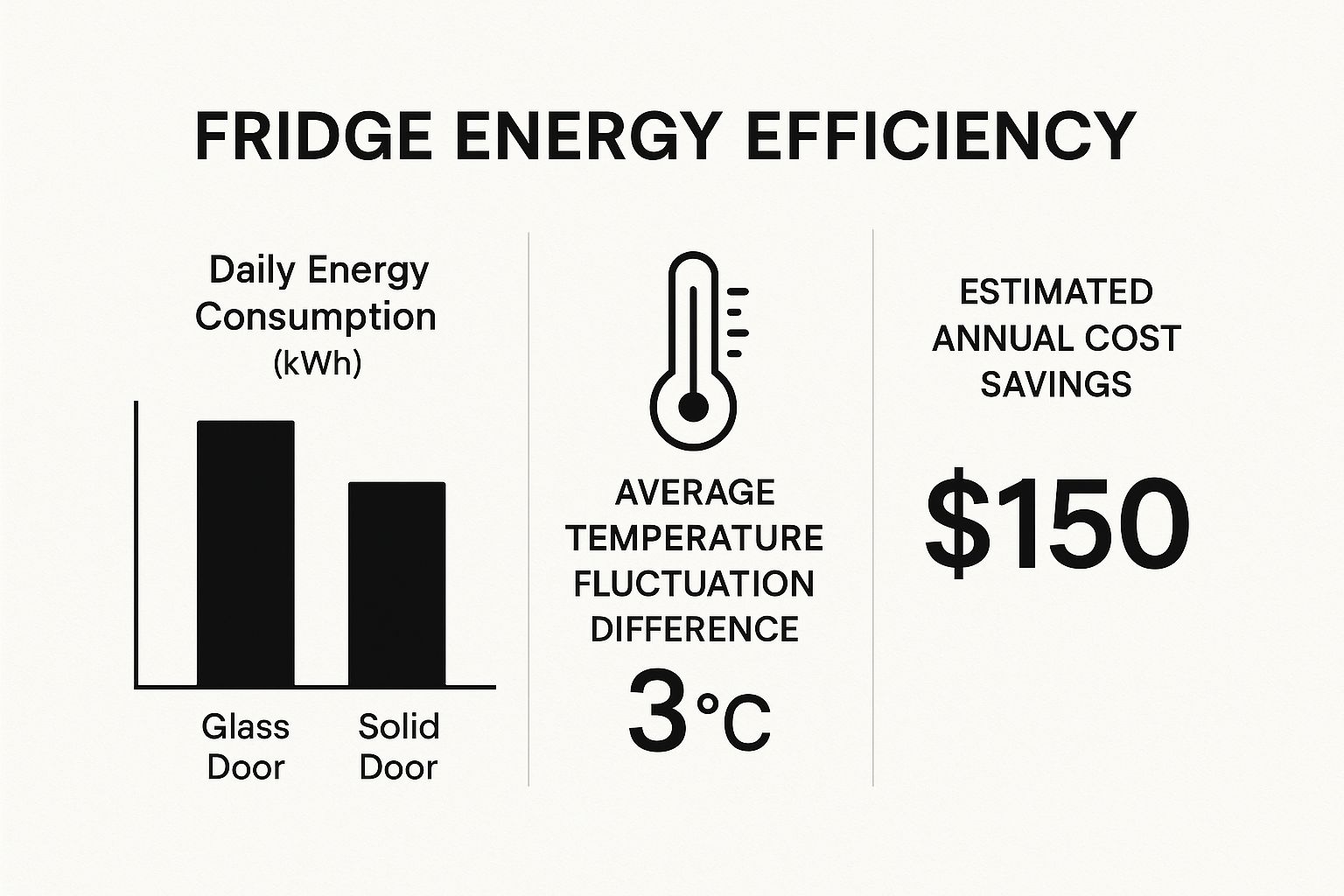
The data makes it clear: the visibility you gain from a glass door doesn't have to come at a high energy cost. Modern units translate that quick grab-and-go access into lower energy use and more stable temperatures, which means real savings over time.
Before we move on, let's pull these key pizzeria-specific features into a quick-reference table. This helps clarify why each component is so crucial in a fast-paced pizza environment.
Essential Glass Door Fridge Features for Pizzerias
| Feature | Why It Matters for a Pizzeria | Look For |
|---|---|---|
| Self-Closing Doors | Prevents cold air loss during the dinner rush when staff are grabbing ingredients quickly. Reduces compressor strain and energy waste. | Magnetic gaskets, weighted or spring-loaded hinge mechanisms. |
| Heavy-Duty Shelving | Supports the weight of bulk ingredients like 40-lb cheese blocks and heavy sauce containers without sagging. | High weight capacity ratings (e.g., 90+ lbs per shelf), steel construction. |
| Rapid Temp Recovery | Quickly brings the internal temperature back to safe levels after frequent door openings, protecting food quality and safety. | High-BTU compressors, efficient fan and airflow systems. |
| Triple-Pane, Low-E Glass | Minimizes condensation in hot, humid kitchens. Improves insulation, reduces energy consumption, and keeps products visible. | Manufacturer specs explicitly mentioning "triple-pane" and "Low-E coating." |
Investing in a fridge with these features isn't about luxury; it's about buying a tool that's properly equipped for the job you're asking it to do day in and day out.
The Innovation Driving Better Fridges
This push for smarter, tougher features is happening across the industry. The global glass door refrigerator market is seeing a ton of innovation as manufacturers compete to build better equipment. Much of this is driven by the demand for energy-efficient appliances, leading to things like advanced compressors and Low-E glass that cut down your operating costs.
You can dive into these strategic market insights to see where the technology is headed. By choosing a model with these modern features, you’re not just buying a fridge for today—you're investing in a piece of equipment built for the future of food service.
Integrating Your Fridge with a Pizza Prep Table
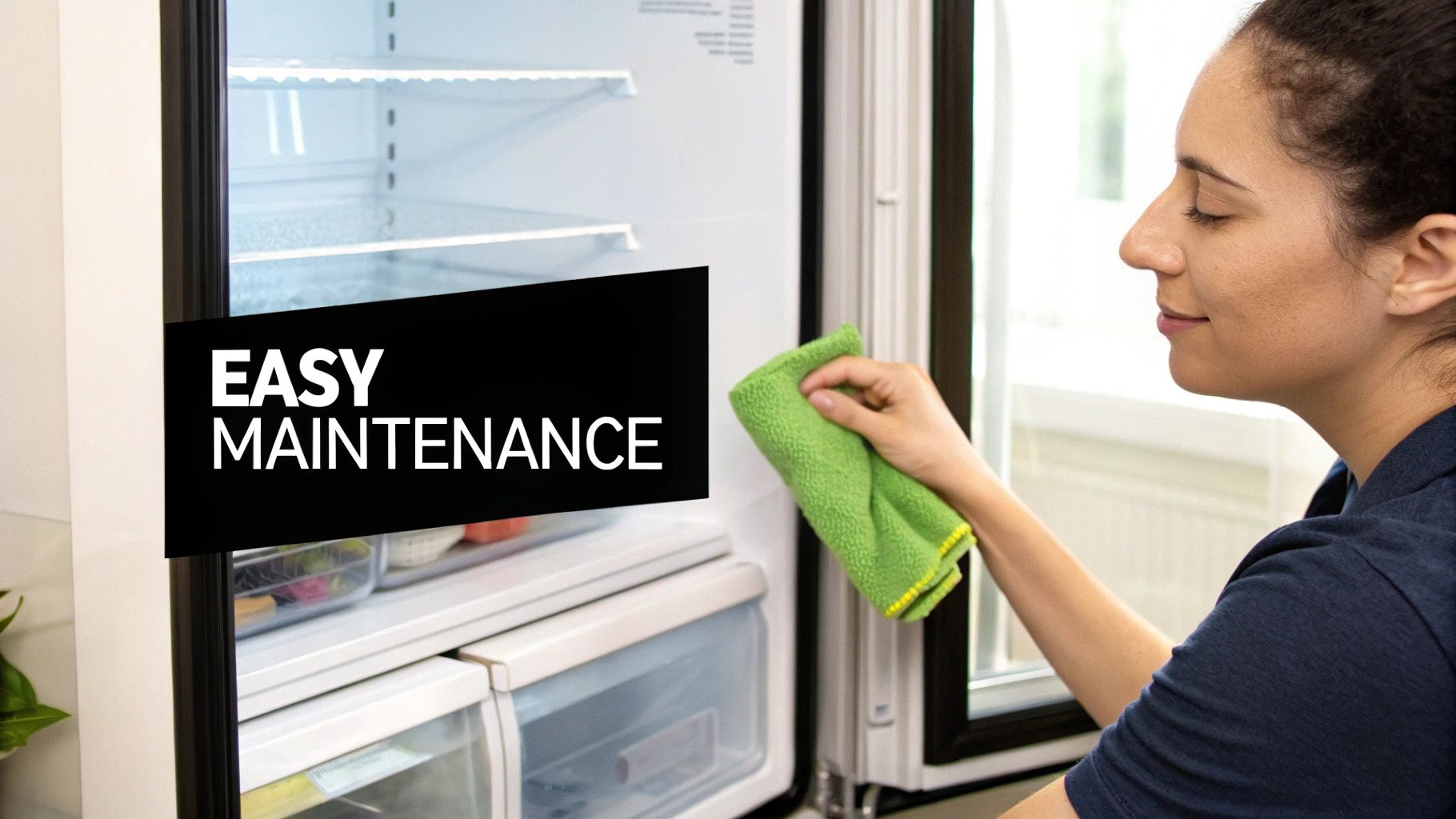
The flow in a great pizzeria kitchen feels like a well-choreographed dance. In this performance, the partnership between your glass door fridge and the pizza prep table is the lead couple. How they work together dictates the rhythm of your entire operation.
Creating a seamless, ergonomic workspace isn't just about comfort; it's about shaving valuable seconds off every single order. This is where smart layout directly translates into profit. By minimizing wasted motion and keeping essential ingredients within arm's reach, your team can assemble pizzas faster, more consistently, and with less physical strain. This boosts not only morale but your kitchen's maximum output during those critical peak hours.
Designing the Pizza-Making Triangle
Just like the classic work triangle in a home kitchen, a pizzeria has its own "pizza-making triangle." The three points are typically the dough storage, the ingredient station (your prep table), and the oven. A strategically placed glass door fridge is the key to shrinking this triangle and making your workflow incredibly efficient.
The goal is simple: eliminate unnecessary steps. Every trip a pizzaiolo takes across the kitchen to grab more cheese or pepperoni is time not spent making pizzas. Smart integration ensures that everything they need is part of a single, fluid motion.
By thoughtfully placing your refrigeration, you create a self-contained workstation. This layout allows a single staff member to stretch dough, top a pizza, and send it to the oven without ever taking more than one or two steps.
Common Fridge Integration Strategies
There's no single magic bullet for layout; the right strategy depends entirely on your kitchen's size and volume. That said, most successful pizzerias use a combination of these proven approaches.
- Large Reach-In Placement: A one- or two-door glass door fridge positioned directly behind the pizza prep table acts as the main ingredient hub. This setup is ideal for holding bulk items like cheese, sauce, and high-volume toppings, allowing for quick restocking of the prep table's refrigerated rail.
- Undercounter Integration: This is a game-changer for speed. Embedding a smaller, undercounter glass door fridge directly beneath the pizza prep table's work surface keeps backup containers of shredded cheese, sliced meats, and prepped vegetables right where they are needed most. It completely eliminates the need to leave the station.
- Countertop Glass Units: For smaller stations or specialty ingredients, a compact countertop glass door fridge can be invaluable. It's perfect for holding items that need strict temperature control but are used less frequently, like marinated artichokes or fresh mozzarella.
This kind of thoughtful placement turns your equipment into a cohesive system. For an in-depth look at the workstations themselves, exploring a guide to the best commercial pizza prep table can provide even more insight into building the perfect setup.
Ultimately, the right integration makes your kitchen work smarter, not harder, letting your team focus on crafting perfect pizzas instead of running back and forth for supplies.
Thinking Beyond the Sticker Price: Energy Use and Operating Costs
That shiny new glass door fridge comes with a price tag, but that’s just the first payment. The real cost of ownership shows up on your utility bill, month after month. For a pizzeria where every penny counts, looking past the initial price to understand the long-term operating expense isn't just a good idea—it's critical for staying profitable.
Let's cut through the technical jargon. The easiest way to start is by looking for the ENERGY STAR label. That little blue sticker is more than just decoration; it’s a promise from the U.S. Environmental Protection Agency that the unit is built to run efficiently. Choosing a certified model means you're buying a fridge that’s designed to save you money right out of the box. For any pizza shop serious about its bottom line, selecting energy-efficient appliances is one of the smartest moves you can make.
Where You Put the Compressor Really Matters
In a pizzeria, flour dust is part of the atmosphere. That’s why the location of the compressor—the engine that powers your fridge—is a huge deal. It directly impacts how efficiently your fridge runs and how much maintenance it will need. You’ve got two choices: top-mounted or bottom-mounted.
-
Top-Mounted Compressors: These units sit on top of the fridge, where they pull in cooler, cleaner air from above the kitchen chaos. In a pizza kitchen, this is a massive win. It keeps the compressor far away from the flour, dough bits, and other gunk on the floor, which means less risk of clogging and overheating. You’ll spend less time cleaning it and more time making pizzas.
-
Bottom-Mounted Compressors: While these are often easier to get to for maintenance and give you more ergonomic storage on the bottom shelf, they are magnets for floor debris in a pizzeria. The compressor has to work harder breathing in hotter air near the floor, and you’ll be cleaning it constantly to keep flour from choking the system.
For just about any pizzeria, a top-mounted compressor is the way to go. It’s a simple design choice that will save you countless hours in maintenance and help you dodge expensive, kitchen-stopping breakdowns.
The demand for reliable and efficient refrigeration is only growing, especially as more restaurants pop up around the world. While North America and Europe are the biggest markets right now, there's a huge opportunity for growth in places that are just starting to build out modern kitchens. You can see some of these trends in these glass door fridge market dynamics and get a feel for where the industry is heading.
Ultimately, choosing a fridge that keeps your long-term costs low is a strategic business decision. For a deeper dive, our guide to energy-efficient commercial refrigeration has even more tips. By focusing on the total cost of owning the machine, not just buying it, you’re setting your pizzeria up for success.
Keeping Your Fridge in Peak Condition
In a busy pizzeria, flour is basically part of the air. It’s essential to the craft, but it’s also the number one enemy of your glass door fridge. The best way to protect your investment and keep your ingredients perfectly chilled isn’t some complicated secret—it’s just a simple, consistent maintenance plan.
Think of it as a small insurance policy for your kitchen's workhorse. Just 15 minutes a week can stop a minor annoyance from snowballing into a full-blown, kitchen-stopping emergency. This isn't just about wiping things down; it’s about proactively keeping your unit running at its best for years, which saves you a ton on energy bills and potential repair costs.
The Pizzeria Maintenance Checklist
Let's be honest, a pizza kitchen is a tough environment for any piece of equipment. Flour dust clogs up everything, and acidic ingredients like tomato sauce are always looking for a surface to damage. Here’s a straightforward game plan to fight back.
- Clean Condenser Coils Monthly: Flour dust is like a magnet for condenser coils, choking them and forcing the compressor to work way harder than it should. This drives your energy bills through the roof. Unplug the unit, grab a stiff brush and a vacuum, and gently clear away all that buildup.
- Wipe Up Spills Immediately: Spills are going to happen, but acidic ones from tomato sauce or vinaigrettes can actually corrode metal and stain your shelves if they sit too long. A quick wipe with a mild, food-safe cleaner is all it takes to prevent long-term damage.
- Inspect Door Gaskets Weekly: That rubber seal around the door is critical for efficiency. Check it for cracks, brittleness, or any gaps. Here's a quick trick: close the door on a dollar bill. If you can slide it out easily, the seal is weak and probably needs to be replaced.
- Keep the Glass Streak-Free: The whole point of a glass door fridge is seeing what you have without opening the door. Use a food-safe glass cleaner to keep that view crystal clear. It reinforces the core benefit of the fridge and saves energy.
A well-maintained refrigerator doesn't just run better—it telegraphs professionalism. It’s a clear signal to your staff, and even the health inspector, that you take quality and safety seriously in every corner of your operation.
For more complex problems that go beyond routine cleaning, it’s always best to call in a pro. But sometimes, you can tackle minor issues yourself. For instance, if you're dealing with a common appliance headache, you might find guides with helpful DIY solutions for refrigerator ice maker problems that can get things working again. Either way, keeping a reliable technician's number handy is always a smart move.
Got Questions? We've Got Answers.
When you're in the weeds of choosing or running your kitchen gear, specific questions always come up. It’s the little details that can make or break a busy shift. This is where we tackle the most common questions we hear from pizzeria owners about their glass door fridges.
Think of this as your quick-reference guide. These are the things that separate a smooth operation from a chaotic one.
What’s the Perfect Temperature for a Pizza Prep Fridge?
You want to keep that fridge humming between 35°F and 38°F (that’s 1.6°C to 3.3°C). This is the absolute sweet spot. It's cold enough to keep your cheese, meats, and veggies perfectly fresh and safe, but not so cold that it freezes delicate items like fresh basil.
More importantly, this range preserves the ideal texture of your pizza dough, keeping it ready for action without getting frosty.
Top-Mounted vs. Bottom-Mounted Compressor: Which is Better for a Pizzeria?
For just about any pizzeria, a top-mounted compressor is the only way to go. Seriously. It’s positioned up high, pulling in cooler, cleaner air from above the kitchen chaos. This keeps it far away from the flour dust and foot traffic that inevitably covers your floor.
It’s a smart design that means you'll spend way less time dealing with clogs and cleaning.
Sure, a bottom-mounted unit might be a tad easier for a technician to access, but in a high-flour environment like a pizza shop, it’s a constant maintenance headache. That convenience is rarely worth the endless cleaning.
How Often Should I Clean the Condenser Coils in a Pizza Kitchen?
In a pizzeria, you need to be cleaning those condenser coils every single month. Flour is the mortal enemy of a condenser coil. It’s incredibly good at creating a thick, insulating blanket that chokes your compressor.
When that happens, your fridge has to work overtime, your energy bill skyrockets, and you’re setting yourself up for a very expensive and very predictable failure. A few minutes with a stiff brush and a vacuum is the best preventative maintenance you can do.
Ready to build an efficient workflow that makes every shift smoother? Pizza Prep Table has the tough-as-nails glass door refrigerators and prep stations you need. Check out our full collection and find the perfect fit for your kitchen at https://pizzapreptable.com.
